
Colonels exercise command and control over regiment level positions. They have the final say in all decisions that affect the regiment and the success or failure that comes with it.
Requirements
- Unknown.

The Lieutenant Colonel is the standard of excellence for a battalion level commander. The candidate who receives this rank has dedicated time and effort to the workings of the community. The holder of this rank also has a passion and drive to make the unit a better place on a daily basis.
The goal of a Lieutenant Colonel is to command Battalion sized elements. They have the final say on actions within the battalion and thus, accept the responsibility of the success or failure of his or her element.
Requirements
- Unknown.

Majors have proven themselves in a company level position. They continue to provide positive and constructive decisions for the unit as a whole. Majors can serve as battalion commander, regimental level staff, or even as regimental executive officers. All eyes are on the Major, as earning their oakleaves is more than just pinning them onto their uniform.
Much like the 2LT is to the 1LT, the Major is fresh to battalion level command, and does well to heed the advice of their senior officers.
Requirements
- Unknown.

Captains are the standard of excellence of a leader. The Captain has universal respect from the entire unit and fellow Officers and has made the unit a better place because of their decisions.
Captains are commonly company commanders with the possibility of remaining at a platoon level if the unit requires.
Requirements
- Promoted personally by company headquarters.
- Letter of recommendation from a company level individual of higher rank than Captain (CPT).
- Open company level billet OR if the individual retains a platoon leader position, they must receive a letter of recommendation from the Company Commander to promote the individual from First Lieutenant.
- Exercises command and control over a large majority of the unit.
- Willingness to go above and beyond in every circumstance.
- Displays extreme work ethic, commitment, drive and valor within the 28th.

The First Lieutenant has proven themselves as a competent leader and a trusted part of the unit leadership. They have earned the confidence of the members and continue to improve his command and unit as a whole.
Individuals that hold the rank of First Lieutenant are often platoon leaders, or company level executive officers. In addition to this, First Lieutenants can also be company commanders if the demand is present.
Requirements
- Promoted personally by company headquarters.
- Letter of recommendation from a company level individual of higher rank than First Lieutenant (1LT).
- Displays skill in the command and control of their platoon.

As the PV2 is the Junior Soldier and the CPL is the Junior NCO, the 2LT is the Junior Officer, learning what it means to no longer wear stripes. Second Lieutenants are freshly minted leaders, and do well to take the advice of their Senior NCO.
Second Lieutenants are often infantry platoon leaders, but can also delve into company level detachment leadership positions such as company medics, company RTOs or company weapons commanders. Additionally, if the demand is present, candidates can be tapped as Second Lieutenants for administrative positions.
Requirements
- Promoted personally by company headquarters after successful completion of Officer Candidate School.
- Letter of recommendation from a company level individual of higher rank than Second Lieutenant (2LT).
- Exercises command and control of their platoon during the OCS phase.
- Willingness to put high levels of time and effort into the unit on a daily basis.

Officer Candidates are members who have decided to take on the next level of leadership and are going through a trail probationary period to prove they have the ability to lead from the level of an Officer. This probationary period is includes completion of Officer Candidate School, where the cadet will be tested and taught on their knowledge of platoon level leadership. Additionally, during this time, the candidate must display high levels of commitment, a good work ethic, and be willing to always go above and beyond for the success of the 28th CAD.
Requirements
- Chosen by the current company headquarters staff to be inducted into Officer Candidate School.
- Exercises command and control over their element at a squad or platoon level NCO position.
- Displayed skill and passion for the wellbeing and success of the unit.
- Must be the rank of E-5, W-3 or higher to be selected.

Chief Warrant Officer Fives are the top of the list as technical and tactical leaders. CW5s are the head of all Warrant Officers and serves as their direct supervisor and role model.
Requirements
- In order to obtain the rank of Chief Warrant Officer Five you must complete the following:
- Mastery in all areas of aviation.
- Ability to teach aviators below them in all areas of aviation.
- Passion to lead those below with positivity and integrity.
- Appointment from the 28th Company Commander via recommendation of your Aviation Platoon Leader.
- 65 days Time in Grade as a Chief Warrant Officer Four.
- 391 days Time in Service in the 28th CAD.

Master-Level Warrant Officers who perform their primary duties that of a technical and tactical leader. They provide direction, guidance, resources, assistance, and supervision necessary for subordinates to perform their duties.
Requirements
- In order to obtain the rank of Chief Warrant Officer Four you must complete the following:
- Obtain the Master Aviators Badge.
- Be a part of three or more staff shops.
- Completion of SLC (Senior Leaders Course)
- Appointment from the 28th Company Commander via recommendation of your Aviation Platoon Leader.
- 60 days Time in Grade as a Chief Warrant Officer Three.
- 326 days Time in Service in the 28th CAD.

Chief Warrant Officer Threes are an intermediate Leader in the technical and tactical advisory role. CW3s are still new to the leadership role and serve as a shadow to those above.
Requirements
- In order to obtain the rank of Chief Warrant Officer Three you must complete the following:
- Completion of ALC (Advanced Leadership Course).
- Be a part of two or more staff shops.
- Approval from your flight leader(s) and aviation platoon leader.
- 55 days Time in Grade as a Chief Warrant Officer Two.
- 266 days Time in Service in the 28th CAD.

Chief Warrant Officer Two is an entry level leader in the technical and tactical advisory role of an primary MOS. CW2s are beginner leaders and take information given to them from higher elements.
Requirements
- In order to obtain the rank of Chief Warrant Officer Two you must complete the following:
- Completion of WLC (Warriors Leadership Course).
- Obtain Senior Aviators Badge.
- Approval from your flight leader(s) and aviation platoon leader.
- 50 days Time in Grade as a Warrant Officer Five.
- 211 days Time in Service in the 28th CAD.

Master-level Warrant Officers who have mastered the ability to perform their primary duties without taking on the extra weight of a leadership role. They are the direct advisor to a Chief Warrant Officer and lead lesser Warrant Officers in the field.
Requirements
- In order to obtain the rank of Warrant Officer Five you must complete the following:
- Show advanced knowledge in operating multiple aircraft.
- Completion of AFA (Attack Fixed Aircraft Course).
- Approval from your flight leader(s).
- 45 days Time in Grade as a Warrant Officer Four.
- 165 days Time in Service in the 28th CAD.

Expert-level Warrant Officers who can excel in their duties of a technical and tactical advisor without the added responsibility of Leadership. They provide guidance, assistance, and supervision when necessary. They teach and train subordinates to perform their duties.
Requirements
- In order to obtain the rank of Warrant Officer Four you must complete the following:
- Show advanced knowledge in operating a single aircraft.
- Completion of ARA (Attack Rotary Aircraft Course).
- Approval from your flight leader(s).
- 25 days Time in Grade as a Warrant Officer Three.
- 81 days Time in Service in the 28th CAD.

Advanced-level experts who can perform the primary duties that of a technical and tactical advisor without the added responsibility of leadership. They provide direction, guidance, and assistance when necessary for subordinates to perform their duties.
Requirements
- In order to obtain the rank of Warrant Officer Three you must complete the following:
- Show proficient knowledge in operating multiple aircraft.
- Completion of CLS (Combat Lifesaver Course).
- Obtain the Aviators Badge.
- Approval from your flight leader(s).
- 20 days Time in Grade as a Warrant Officer Two.
- 56 days Time in Service in the 28th CAD.

Warrant Officer Twos are intermediate level technical and tactical experts who have decided to pursue a course in their MOS without the added responsibility a Chief would pick up.
Requirements
- In order to obtain the rank of Warrant Officer One you must complete the following:
- Display proficiency on a single aircraft.
- Completion of CCC (Crew Chief Course).
- Approval from your flight leader(s).
- 16 days Time in Grade as a Warrant Officer One.
- 36 days Time in Service in the 28th CAD.

Warrant Officer Ones are technical and tactically focused officers who perform the primary duties of a technical leader, trainer, operator, manager, and maintainer. Warrant Officer Ones are the junior roles of their MOS.
Requirements
- In order to obtain the rank of Warrant Officer One you must complete the following:
- Display proficiency on the UH-60 Blackhawk.
- Ability to solo pilot the UH-60 Blackhawk.
- Approval from your flight leader(s).
- 13 days Time in Grade as a Warrant Officer Cadet.
- 20 days Time in Service in the 28th CAD.

Warrant officer candidates as fresh recruits to a specific trade. They are ready to learn the ropes and prove themselves as competent aviators or staff shop members. They do well to listen to their senior warrant officers, and learn by watching rather than doing.
Requirements
- In order to obtain the rank of Warrant Officer Cadet you must have the following:
- Complete enlistment into the 28th.
- Complete basic training and 11B MOSQ.
- Serve for 4 operations as an Infantryman.
- Aviation must have an open billet.
- If chosen, complete 153A MOSQ and additional trainings.

Description
- The Sergeant Major is the most Senior NCO of a Battalion level unit, and with their leadership, experience, and willingness to go above and beyond, NCOs and Officers alike can look to the Sergeant Major for support on any level. They insure that the Battalion is trained, disciplined and ready for any challenge, and is a key figure in the success of a unit such as ourselves. The Sergeant Major has allowed many members to benefit from their decisions, and not only puts their success before their own, but insures that each member they interact with is a better soldier, person and member of the 28th CAD.
Role
- The primary role of an Sergeant Major is to follow the orders of an assigned Officer In Charge.
- The secondary role of an Sergeant Major is to delegate tasks by the OIC or supervisory NCO in charge to lesser NCOs.
- The tertiary role of an Sergeant Major is to help step up in leadership when the assigned supervisory leader is away and guide the assigned command.
- The quaternary role of a Sergeant Major is to attend courses hosted by TRADOC to expand their knowledge.
- the quinary role of a Sergeant Major is to create trainings and increase the overall proficiency of their assigned element.
Requirements
- In order to obtain the rank of Sergeant Majoryou must have the following:
- 600 calendar days honorable Time In Service (TIS) in the unit.
- Must have completed Master Leaders Course (MLC)
- Must be in a Company Level Position, with an open Battalion Level Position to move into.
- Does not currently have a punitive flag against themselves.
*Course titles may vary. Ask Unit Leadership for more information.
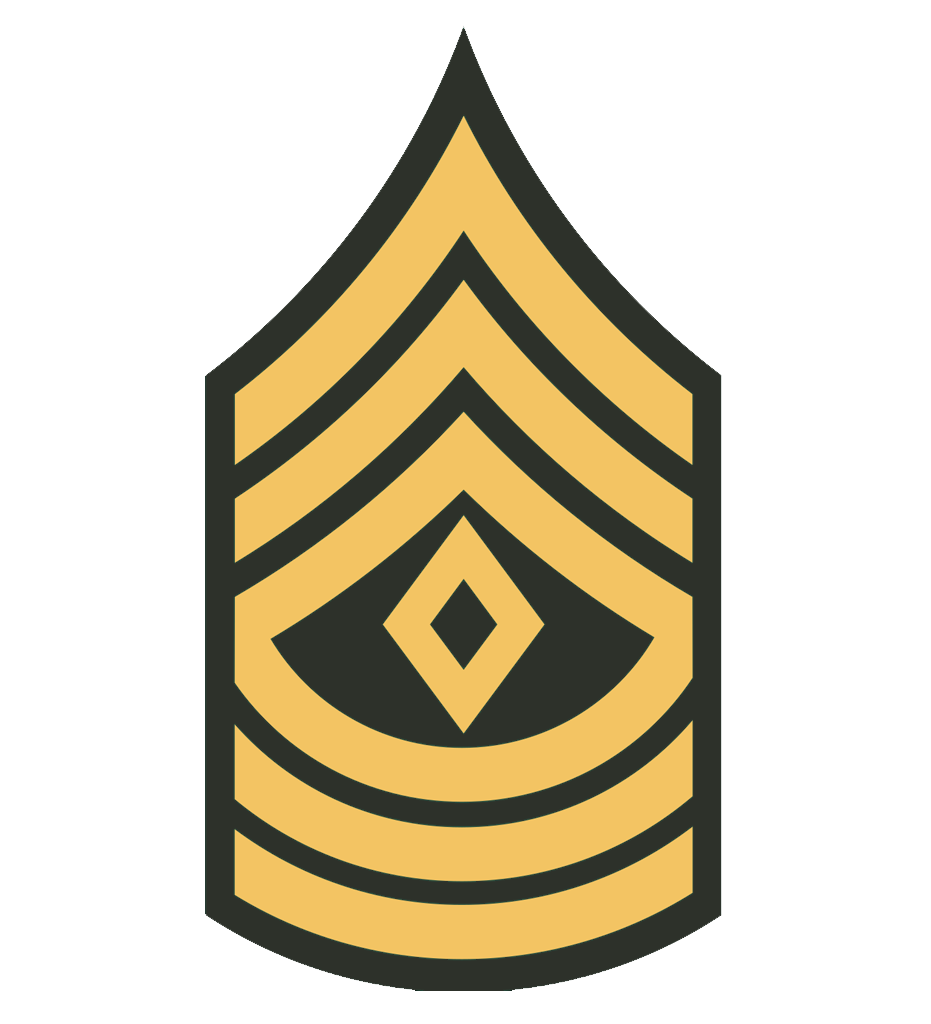
Description
- The rank of 1st Sergeant is the most senior Non-Commissioned Officer in the unit and thus is the most trusted NCO. A 1st Sergeant is the voice for the commander of the unit and controls all NCOs below to accomplish the tasked mission. Paired with every single responsibility, obligation, and requirement assigned as prerequisites for lesser ranks the 1st Sergeant is the "bonding agent" for the unit. Without the 1st Sergeant to help mediate all tasks and issues that may pop up the unit would be a toxic environment for everyone. The rank of 1st Sergeant is signified as three chevrons stacked vertically and three rockers underneath with a diamond in the middle.
Role
- The primary role of an 1st Sergeant is to follow the orders of an assigned Officer In Charge.
- The secondary role of an 1st Sergeant is to delegate tasks by the OIC or supervisory NCO in charge to lesser NCOs.
- The tertiary role of an 1st Sergeant is to help step up in leadership when the assigned supervisory leader is away and guide the assigned command.
- The quaternary role of a 1st Sergeant is to attend courses hosted by TRADOC to expand their knowledge.
- the quinary role of a 1st Sergeant is to create trainings and increase the overall proficiency of their assigned element.
Requirements
- In order to obtain the rank of 1st Sergeant you must have the following:
- 420 calendar days honorable Time In Service (TIS) in the unit.
- Must have completed Master Leaders Course (MLC)
- Must of displayed the characteristics and factors needed to become an NCO.
- Must be in a Company Level Position
- Does not currently have a punitive flag against themselves.
*Course titles may vary. Ask Unit Leadership for more information.
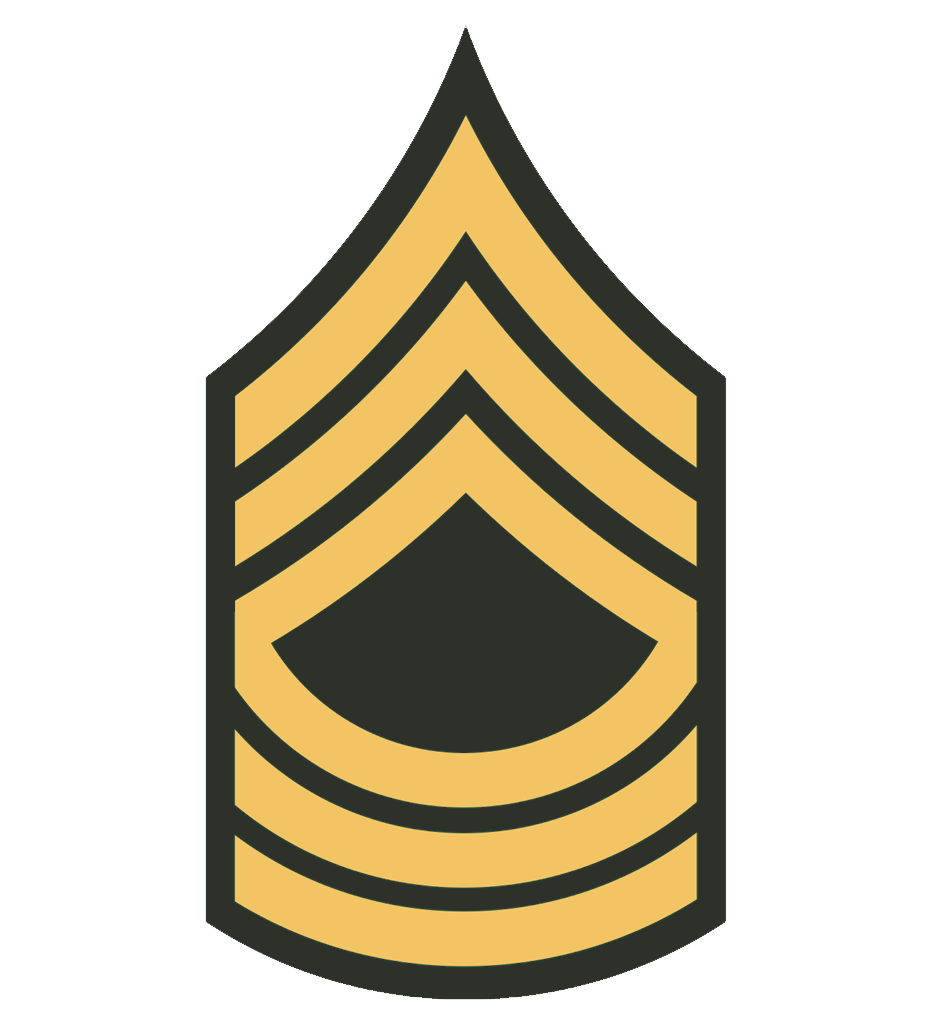
Description
- The rank of Master Sergeant is the entry into Company Command for the unit. A Master Sergeant paired with the 1st Sergeant is the most senior NCO in the unit and serves as a voice of command. A Master Sergeants role is to direct all lower NCOs below to accomplish the mission assigned as hand by an assigned OIC. Like the 1st Sergeant a Master Sergeant is the care-taker, mediator, and liaison for the OICs assigned. When a civil affair comes up a Master Sergeant is tasked with solving any problems. A Master Sergeant can be trusted to be the counselor for the unit and fellow members who may have issues in the unit or in real life. The rank of Master Sergeant is signified as three chevrons vertically stacked and three rockers underneath.
Role
- The primary role of an Master Sergeant is to follow the orders of an assigned Officer In Charge or supervisory NCO.
- The secondary role of an Master Sergeant is to delegate tasks by the OIC or supervisory NCO in charge to lesser NCOs.
- The tertiary role of an Master Sergeant is to help step up in leadership when the assigned supervisory leader is away and guide the assigned command.
- The quaternary role of a Master Sergeant is to attend courses hosted by TRADOC to expand their knowledge.
- the quinary role of a Master Sergeant is to create trainings and increase the overall proficiency of their assigned element.
Requirements
- In order to obtain the rank of Master Sergeant you must have the following:
- 390 calendar days honorable Time In Service (TIS) in the unit.
- Must have completed Master Leaders Course (MLC)
- Must of displayed the characteristics and factors needed to become an NCO.
- Must be in a Platoon Level Billet
- Does not currently have a punitive flag against themselves.
*Course titles may vary. Ask Unit Leadership for more information.
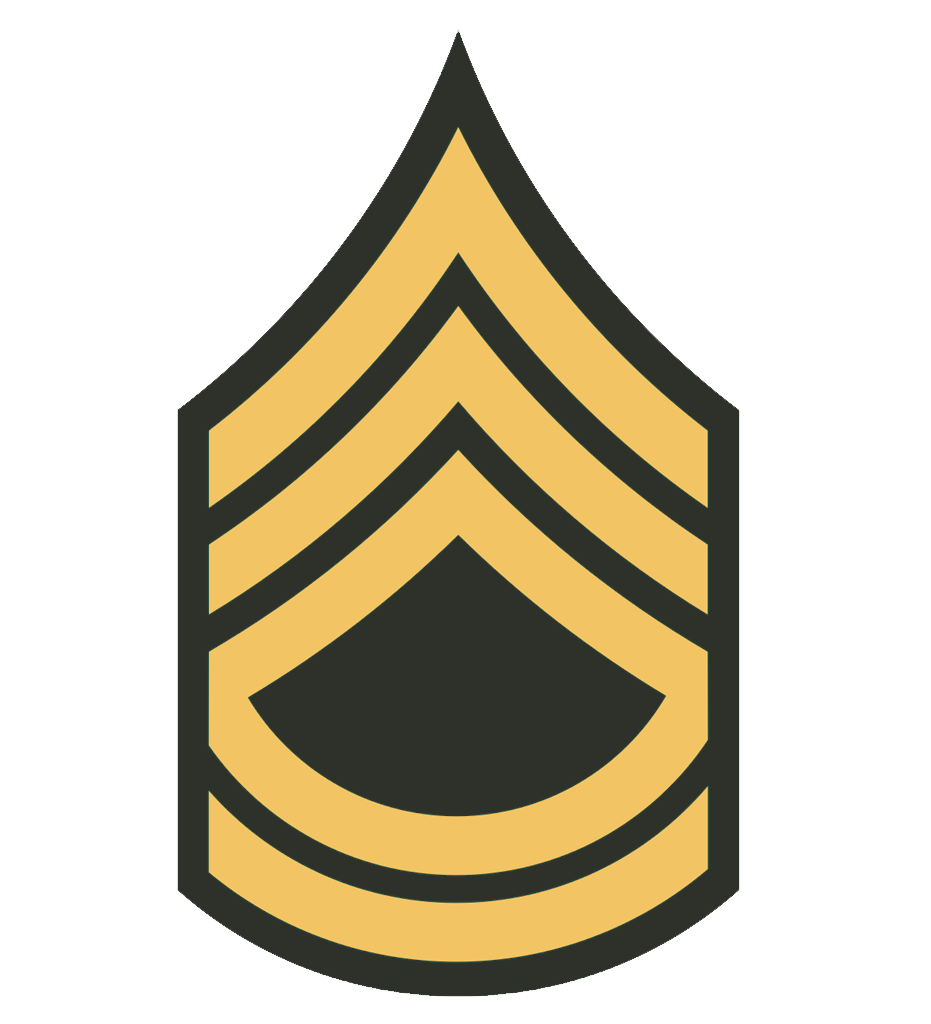
Description
- The rank of Sergeant First Class is the platoon level Non-Commissioned Officer. They have proven themselves not only as an excellent leader in the past, but also as an effective guide for the unit as a whole. They have become a force to be reckoned with inside the company of their assignment and a trusted advisor to higher leadership. A Sergeant First Class is the counselor to all assigned NCOs below and helps direct them to success. The Sergeant First Class is the very definition of an "Senior NCO". The rank of Sergeant First Class is signified as three chevrons vertically stacked with two rockers underneath.
Role
- The primary role of an Sergeant First Class is to follow the orders of an assigned Officer In Charge or supervisory NCO.
- The secondary role of an Sergeant First Class is to delegate tasks by the OIC or supervisory NCO in charge to lesser NCOs.
- The tertiary role of an Sergeant First Class is to help step up in leadership when the assigned supervisory leader is away and guide the assigned command.
- The quaternary role of a Sergeant First Class is to attend courses hosted by TRADOC to expand their knowledge.
- The quinary role of a Sergeant First Class is to create trainings and increase the overall proficiency of their assigned element.
Requirements
- In order to obtain the rank of Sergeant First Class you must have the following:
- 285 calendar days honorable Time In Service (TIS) in the unit.
- Must have completed Senior Leaders Course (SLC)
- Must of displayed the characteristics and factors needed to become an NCO.
- Must be in a Platoon Level Billet
- Does not currently have a punitive flag against themselves.
*Course titles may vary. Ask Unit Leadership for more information.
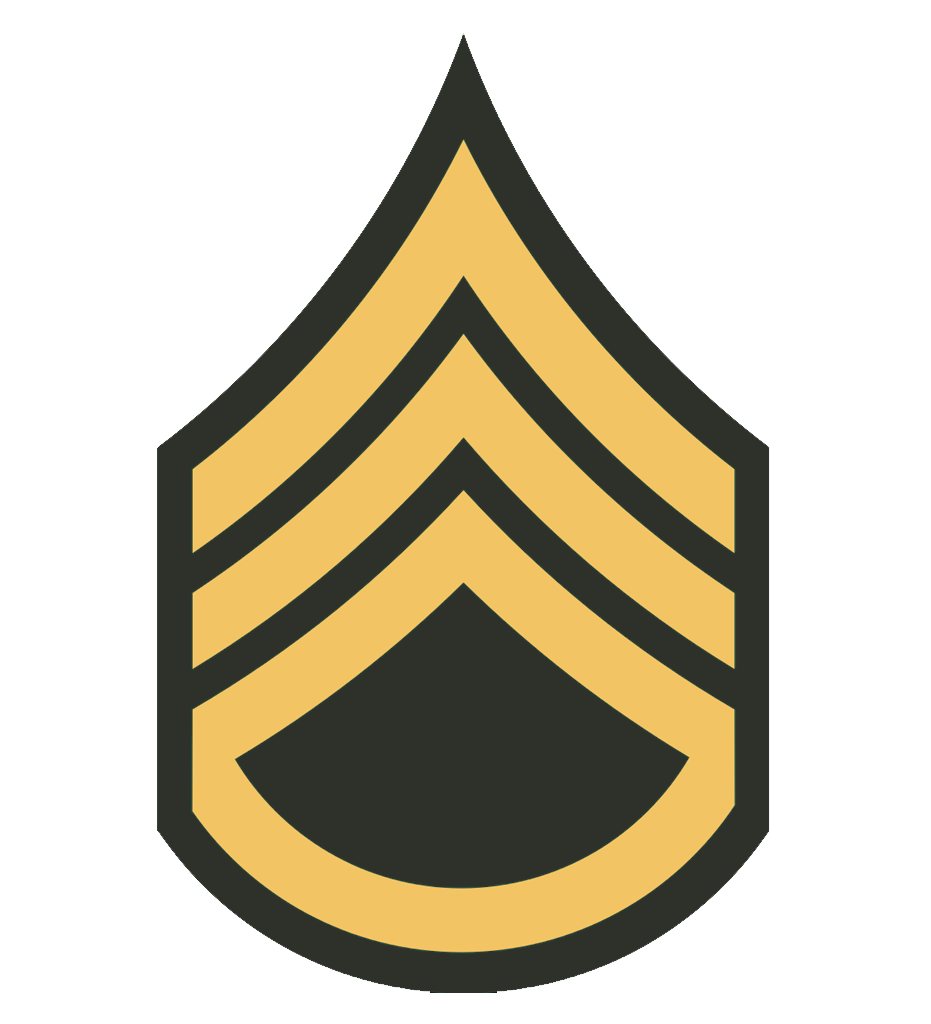
Description
- The rank of Staff Sergeant is a proficient and reliable leader within the unit. Their leadership has now evolved to a crucial part of the overall health of the unit, and not only does the Staff Sergeant excel in leadership, they also show the ability to assist higher leaders when called upon. A Staff Sergeant is the first step in intermediate leadership within the unit an thus comes with its own set of responsibilities, obligations, and requirements. The rank of Sergeant is signified as three chevrons stacked vertically and a rocker underneath.
Role
- The primary role of an Staff Sergeant is to follow the orders of an supervisory NCO or leader.
- The secondary role of an Staff Sergeant is to delegate tasks by the supervisory NCO or leader to a lesser NCO.
- The tertiary role of an Staff Sergeant is to help step up in leadership when the assigned supervisory NCO or leader is away.
- The quaternary role of a Staff Sergeant is to attend courses hosted by TRADOC to expand their knowledge.
- The quinary role of a Staff Sergeant is to create trainings and increase the overall proficiency of their assigned element.
Requirements
- In order to obtain the rank of Staff Sergeant you must have the following:
- 210 calendar days honorable Time In Service (TIS) in the unit.
- Must have successfully completed at least 4 title course through TRADOC.
- Must have completed Advanced Leaders Course (ALC)
- Must of displayed the characteristics and factors needed to become an NCO.
- Must be in a billet for E-6+.
- Does not currently have a punitive flag against themselves.
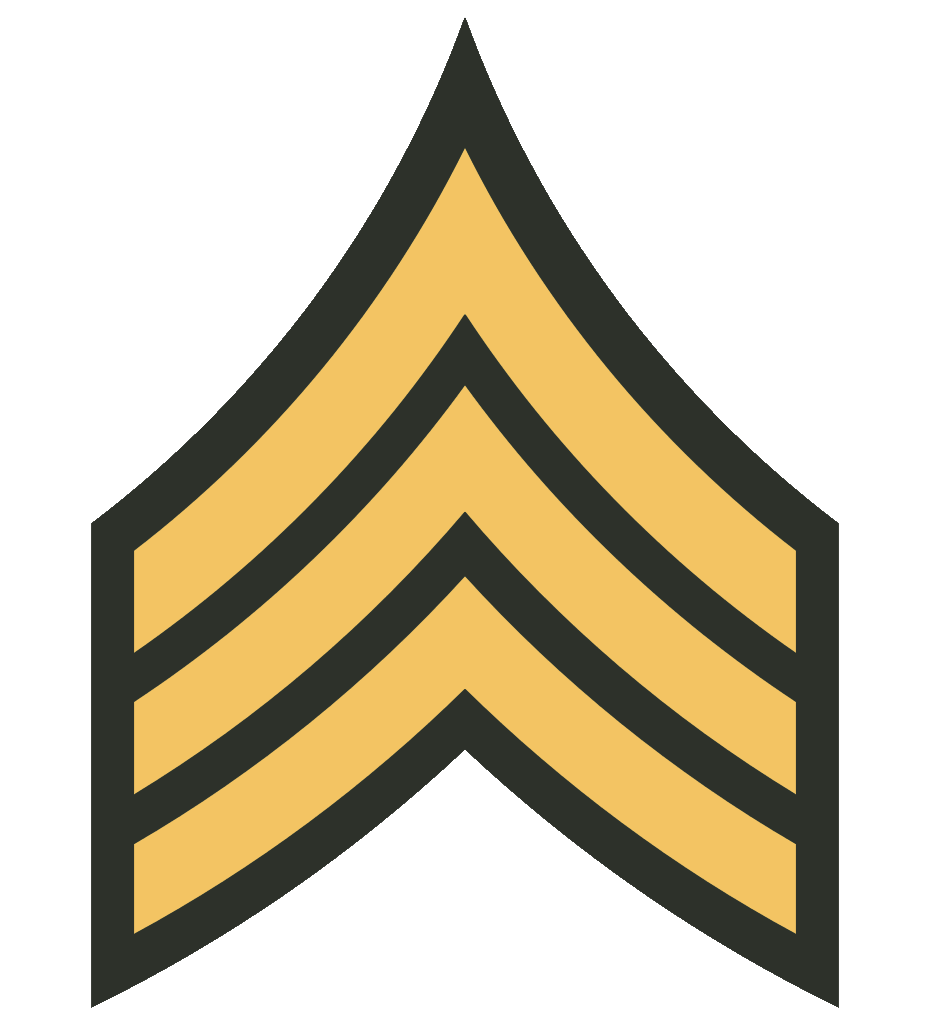
Description
- The rank of Sergeant is the entrée to a hallowed fraternity to which they are now apart of. Sergeants are the backbone and run the unit, of that there can be no doubt. A Sergeant has proven to be a leader that can effectively control a Squad sized element if necessary. The rank of Sergeant is where the axe meets the wood and all responsibilities are on the line. A Sergeant is signified by three chevrons vertically stacked.
Role
- The primary role of an Sergeant is to follow the orders of an supervisory NCO or leader.
- The secondary role of an Sergeant is to delegate tasks by the supervisory NCO or leader to a lesser NCO assigned.
- The tertiary role of an Sergeant is to help step up in leadership when the assigned supervisory NCO or leader is away.
- The quaternary role of a Sergeant is to attend courses hosted by TRADOC to expand their knowledge.
Requirements
- In order to obtain the rank of Sergeant you must have the following:
- 150 calendar days honorable Time In Service (TIS) in the unit and 45 days honorable Time In Grade (TIG).
- Must have successfully completed at least 4 title course through TRADOC.
- Must have competed Advanced Leaders Course (ALC)
- Must of displayed the characteristics and factors needed to become an NCO.
- Does not currently have a punitive flag against themselves.
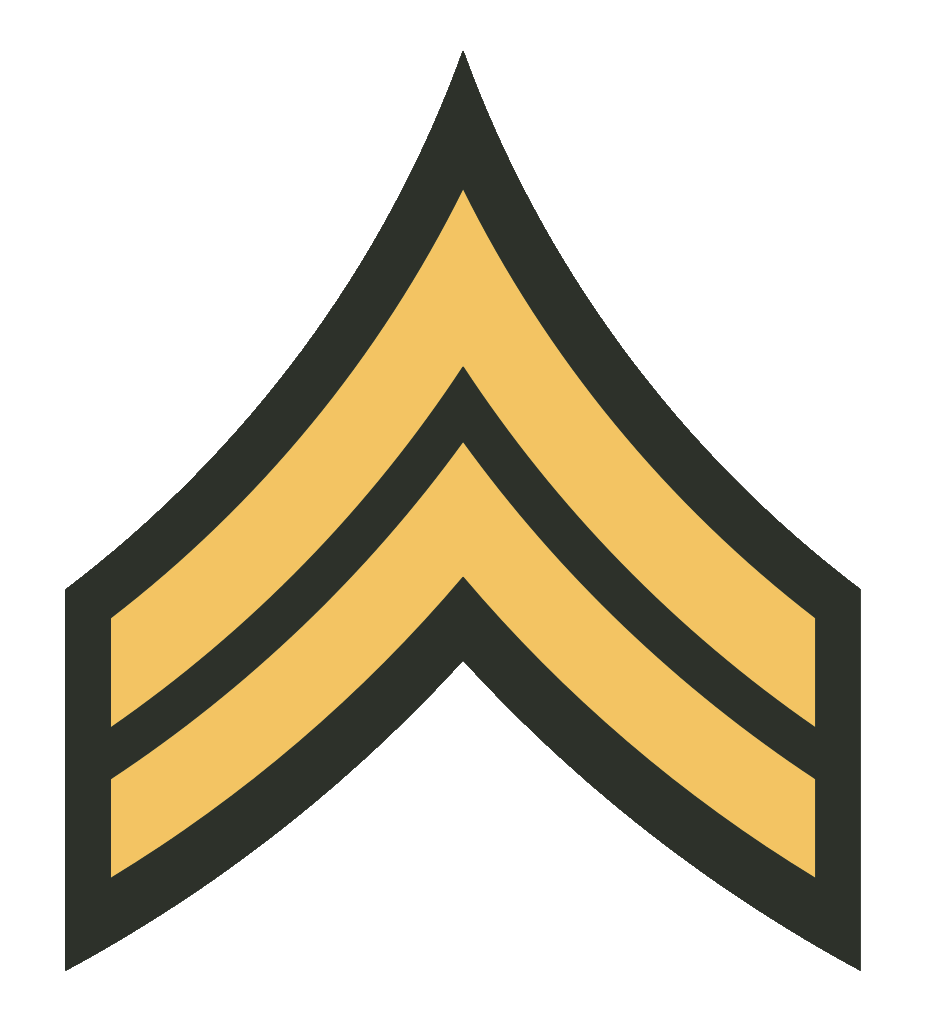
Description
- The rank of Corporal is the beginning step towards leadership inside the 28th Combined Arms Division. Corporals have established themselves as having displayed leadership potential and worthy of future considerations as a higher leader. The rank of Corporal is signified as two chevrons stacked vertically.
Role
- The primary role of an Corporal is to follow the orders of an supervisory NCO or leader.
- The secondary role of an Corporal is to delegate tasks by the supervisory NCO or leader.
- The tertiary role of an Corporal is to help step up in leadership when the assigned supervisory NCO or leader is away.
- The quaternary role of a Corporal is to attend courses hosted by TRADOC to expand their knowledge.
Requirements
- In order to obtain the rank of Corporal you must have the following:
- 105 calendar days honorable Time In Service (TIS) in the unit and 45 days honorable Time In Grade (TIG)
- Must have successfully completed at least 3 title course through TRADOC.
- Must have completed Warrior Leaders Course (WLC)
- Must of displayed the characteristics and factors needed to become an NCO.
- Does not currently have a punitive flag against themselves.
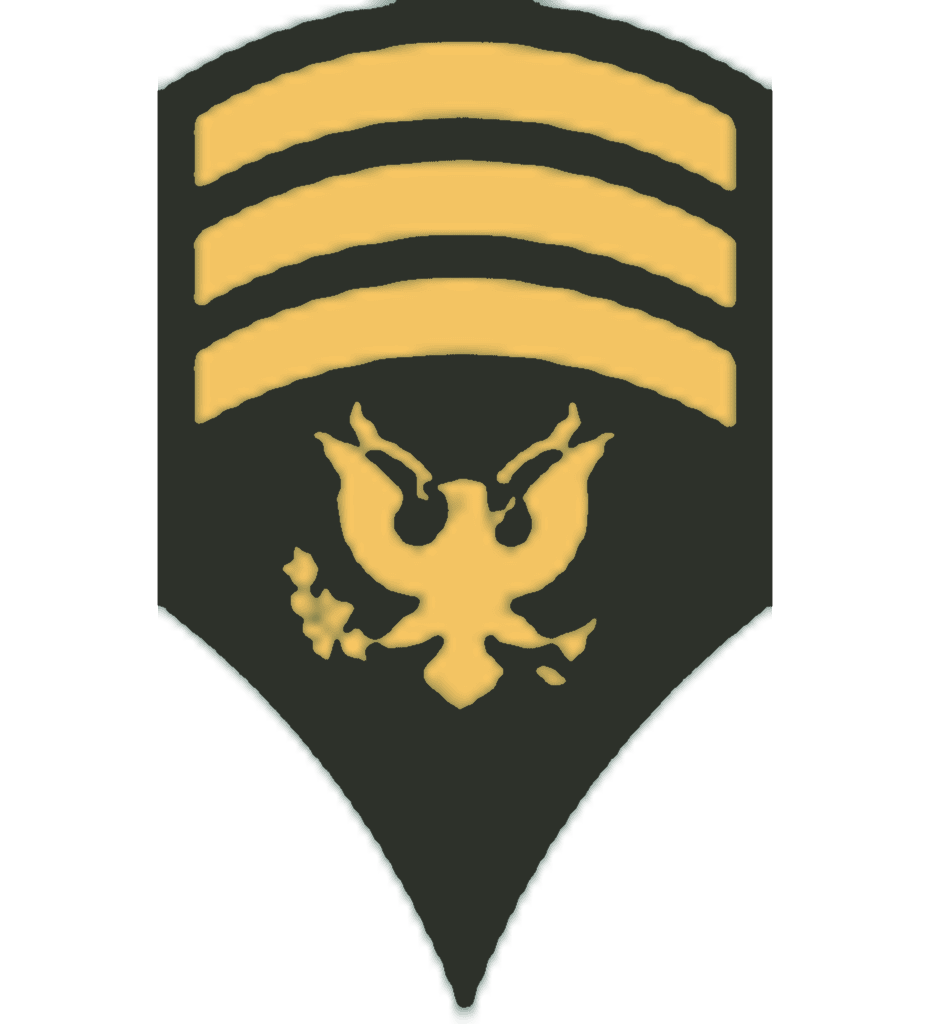
Description
- The Specialist Grade IV is the lateral step into progression of the unit. Those who have been promoted to Specialist Grade IV have either selected to remain in a non-leadership billeted position or are awaiting for a leadership billet to open for selection. Specialist Grade IV much like Specialist is the most senior lower enlisted and contains vast knowledge within the unit and community. A Specialist Grade IV is signified by the original Specialist emblem but with three rounded upside-down rockers on top.
Role
- The primary role of a Specialist Grade IV is to follow the orders of the supervisory NCO or Leader.
- The secondary role of a Specialist Grade IV is to help delegate tasks by the supervisory NCO or Leader.
- The tertiary role of a Specialist Grade IV is to help step up in leadership when the assigned supervisory NCO or Leader is away.
- The quaternary role of a Specialist Grade IV is to attend courses hosted by TRADOC to expand their knowledge.
Requirements
- In order to obtain the rank of Specialist Grade IV you must have the following:
- 180 calendar days honorable Time in Service (TIS) in the unit and 45 days honorable Time in Grade (TIG).
- Must have successfully completed at least 3 title courses through TRADOC.
- Does not currently have a punitive flag against themselves.
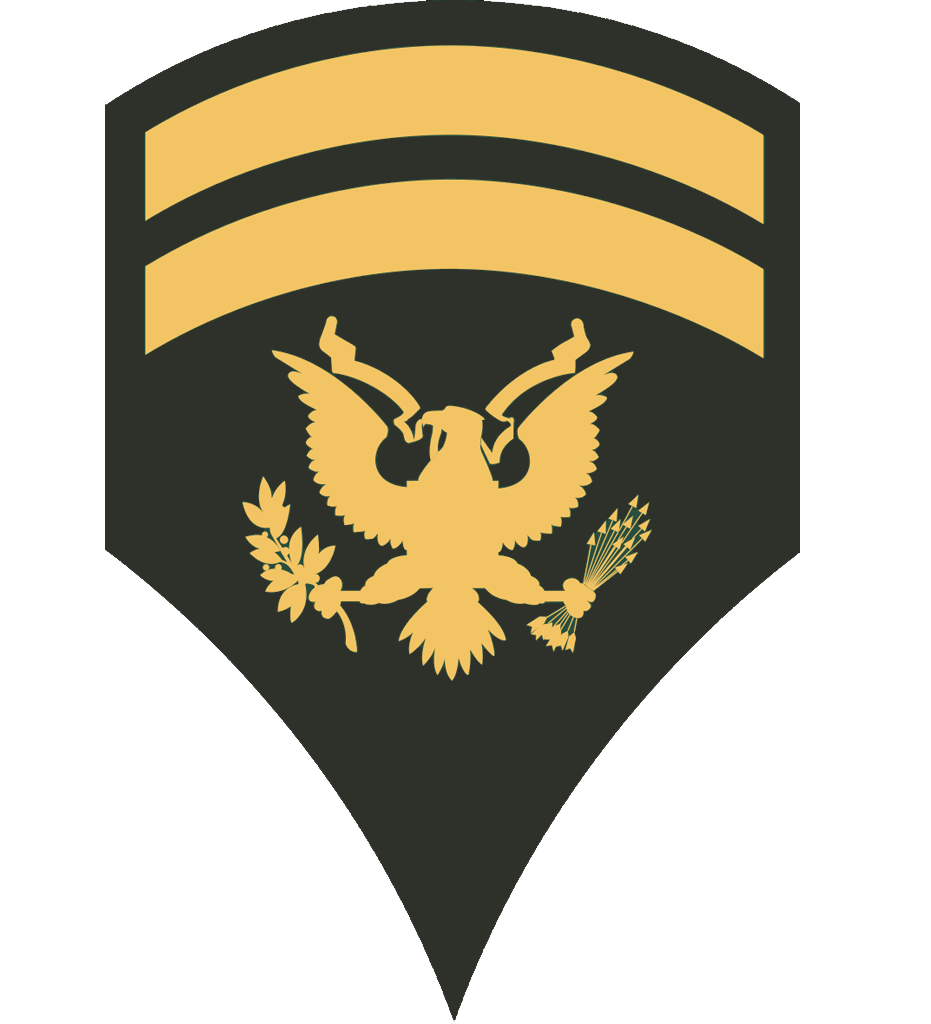
Description
- The Specialist Grade III is the lateral step into progression of the unit. Those who have been promoted to Specialist Grade III have either selected to remain in a non-leadership billeted position or are awaiting for a leadership billet to open for selection. Specialist Grade III much like Specialist is the most senior lower enlisted and contains vast knowledge within the unit and community. A Specialist Grade III is signified by the original Specialist emblem but with two rounded upside-down rockers on top.
Role
- The primary role of a Specialist Grade III is to follow the orders of the supervisory NCO or Leader.
- The secondary role of a Specialist Grade III is to help delegate tasks by the supervisory NCO or Leader.
- The tertiary role of a Specialist Grade III is to help step up in leadership when the assigned supervisory NCO or Leader is away.
- The quaternary role of a Specialist Grade III is to attend courses hosted by TRADOC to expand their knowledge.
Requirements
- In order to obtain the rank of Specialist Grade III you must have the following:
- 180 calendar days honorable Time in Service (TIS) in the unit and 45 days honorable Time in Grade (TIG).
- Must have successfully completed at least 3 title courses through TRADOC.
- Does not currently have a punitive flag against themselves.
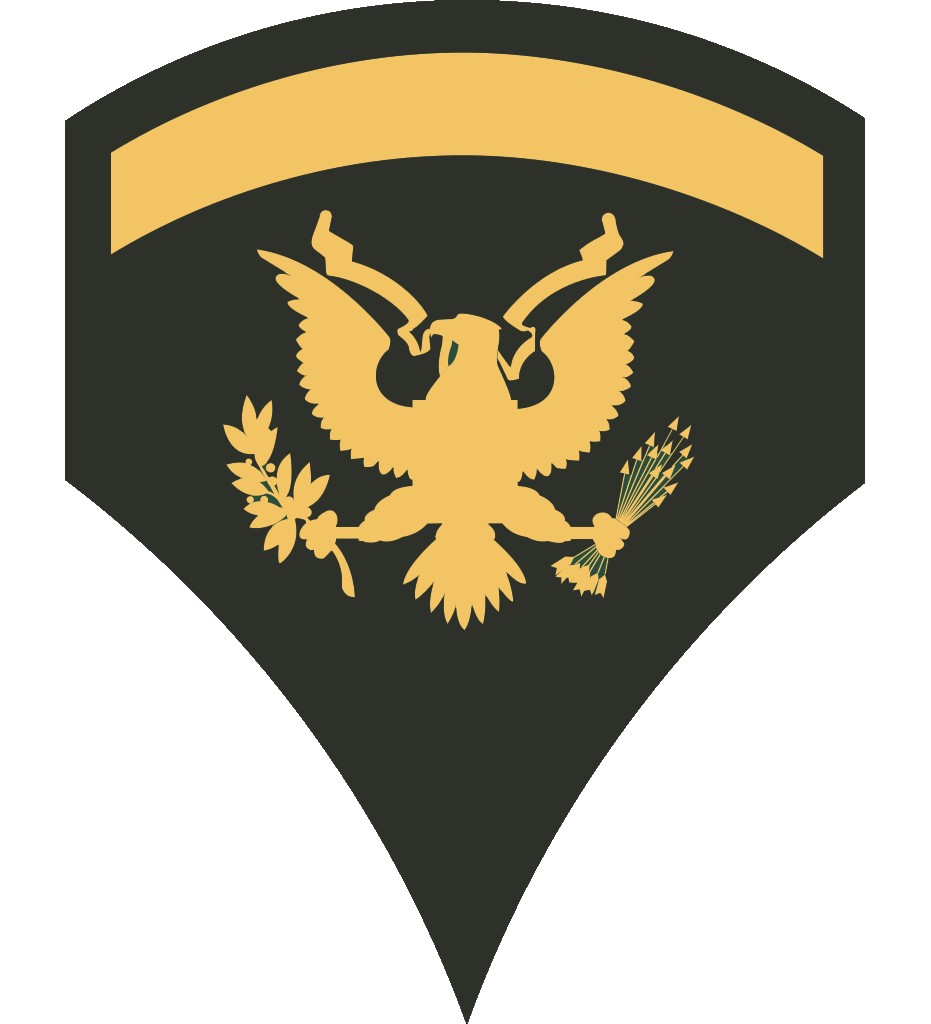
Description
- The Specialist Grade II is the lateral step into progression of the unit. Those who have been promoted to Specialist Grade II have either selected to remain in a non-leadership billeted position or are awaiting for a leadership billet to open for selection. Specialist Grade II much like Specialist is the most senior lower enlisted and contains vast knowledge within the unit and community. A Specialist Grade II is signified by the original Specialist emblem but with a rounded upside-down rocker on top.
Role
- The primary role of a Specialist Grade II is to follow the orders of the supervisory NCO or Leader.
- The secondary role of a Specialist Grade II is to help delegate tasks by the supervisory NCO or Leader.
- The tertiary role of a Specialist Grade II is to help step up in leadership when the assigned supervisory NCO or Leader is away.
- The quaternary role of a Specialist Grade II is to attend courses hosted by TRADOC to expand their knowledge.
Requirements
- In order to obtain the rank of Specialist Grade II you must have the following:
- 135 calendar days honorable Time in Service (TIS) in the unit and 45 days honorable Time in Grade (TIG).
- Must have successfully completed at least 2 title courses through TRADOC.
- Does not currently have a punitive flag against themselves.
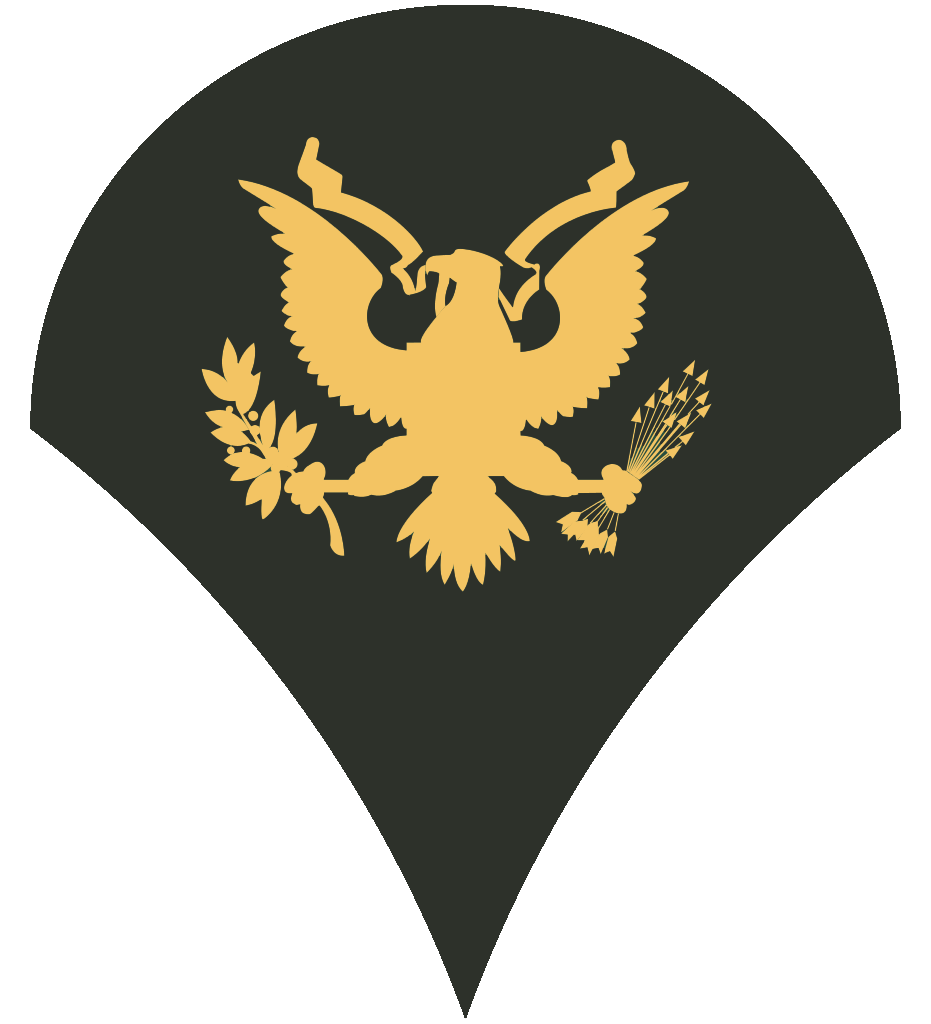
Description
- The Specialist is the top of the line of the junior enlisted ranks. A Specialist is not new but experienced in the unit and how it operates. As a Specialist you are trusted by your supervisory NCO or Leader to help delegate and task lower enlisted personnel and be the mentor for them when the supervisory NCO or Leader isn't there. This is the first step towards leadership within the unit and community. Signified by a dark shield and gold eagle holding arrows, and an olive branch.
Role
- The primary role of a Specialist is to follow the orders of the supervisory NCO or Leader.
- The secondary role of a Specialist is to help delegate tasks by the supervisory NCO or Leader.
- The tertiary role of a Specialist is to help step up in leadership when the assigned supervisory NCO or Leader is away.
- The quaternary role of a Specialist is to attend courses hosted by TRADOC to expand their knowledge.
Requirements
- In order to obtain the rank of Specialist you must have the following:
- 90 calendar days honorable Time in Service (TIS) in the unit and 45 days Time in Grade (TIG).
- Must have successfully completed at least 1 title course through TRADOC.
- Does not currently have a punitive flag against themselves.
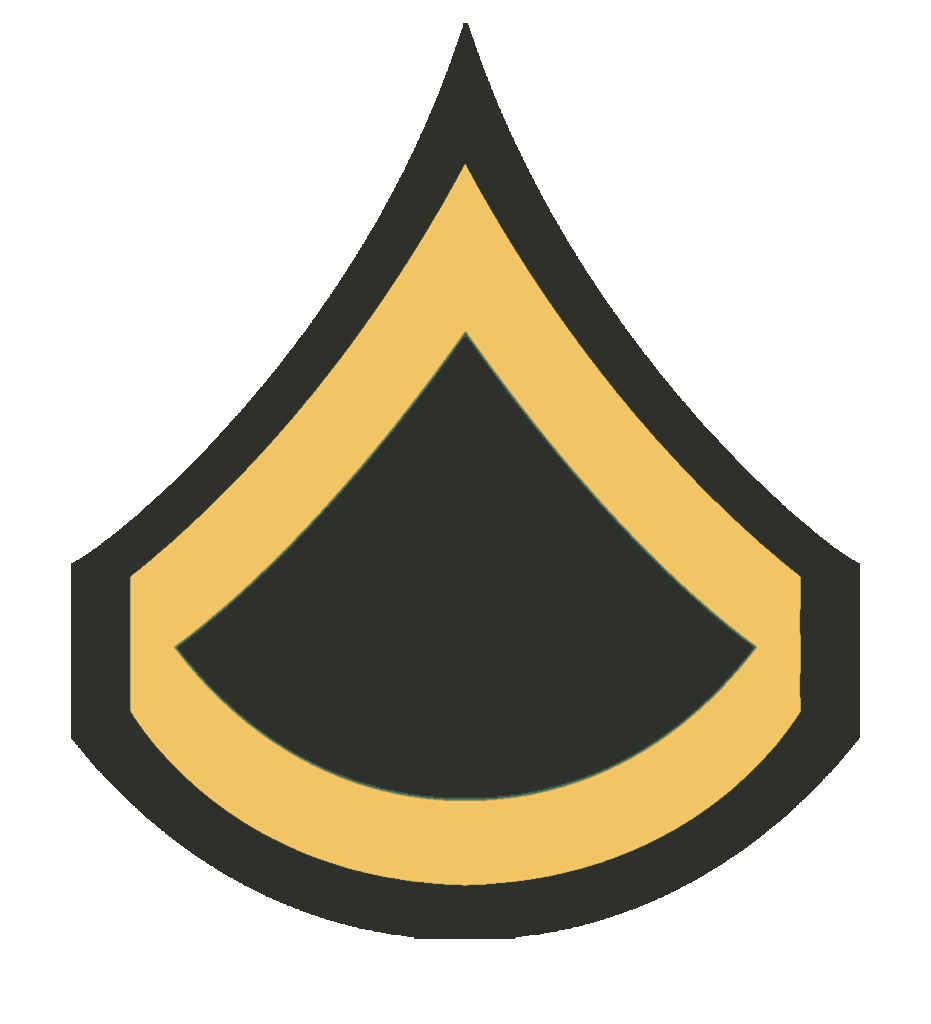
Description
- The Private First Class rank is the first real step towards progression in the unit and community. Those who hold this rank have passed the milestone of induction, training, and the probationary period. Private First Class's can be trusted upon for persistence, dedication, and activity for any role. A Private First Class is the third enlisted rank of the junior enlisted line and follows the orders of their supervisory Non-Commissioned Officer (NCO). The rank is signified by a gold chevron and a rocket underneath.
Role
- The primary role of a Private First Class is to follow the orders of their assigned supervisory NCO or Leader.
- The secondary role of a Private First Class is to complete courses hosted through TRADOC.
Requirements
- In order to obtain the rank of Private First Class you must have the following:
- Must have attended 6 main operations (Friday, Sunday).
- Must have 30 days Time in Service (TIS) and 15 days honorable Time in Grade (TIG).
- Does not currently have a punitive flag against themselves.
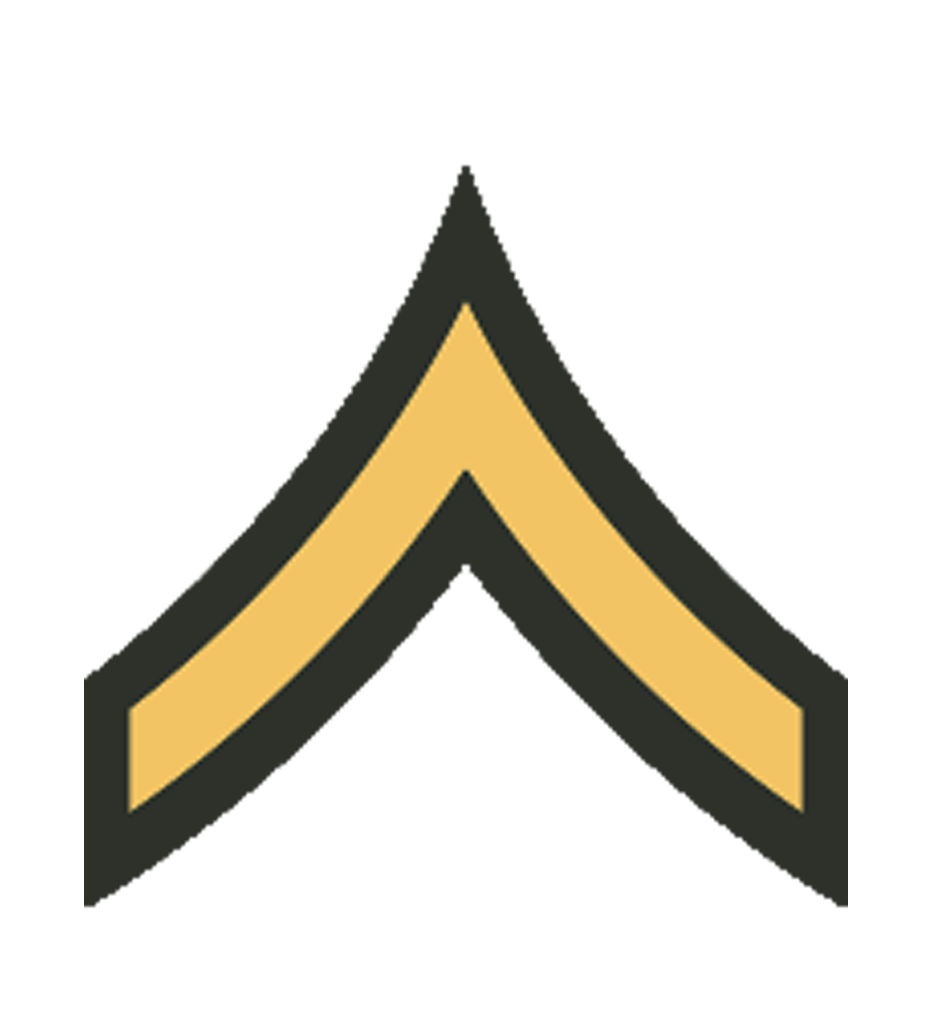
Description
- A Private Second Class is the second step in the progression of the unit. A Private Second Class much like the private is used as a marker for the unit to distinguish who has passed BCT, MOSQ, and has now begun their probationary period. A PV2 is eligible to still serve as a member and fill a dedicated role during operations such as Automatic Rifleman, Grenadier, and MOS demanded positions such as 13F, 19K, and 68W. The rank is signified by a single gold chevron.
Role
- The primary role of a Private Second Class is to be as active as a member as possible given their real life situation and fulfil the two operation probationary period.
Requirements
- In order to obtain the rank of Private Second Class, you must successfully pass BCT and MOSQ while completing the four operation probationary period.

Description
- The rank of private is given to those who have successfully completed their induction process through the Department of Unit Recruiting (DUREC). Private is purely used as a placeholder and a marker to the unit to signify that you have become a fully registered member of the unit, but yet to pass Basic Combat Training (BCT) and Military Occupational Speciality Qualification (MOSQ).
Role
- The primary role of a Private is to complete the BCT and MOSQ for 11B (Infantryman)
Requirements
- In order to obtain the rank of Private you must be inducted as a fully registered member in the 28th Combined Arms Division. The rank of Private is given by DUREC.

Captains are the standard of excellence of a leader. The Captain has universal respect from the entire unit and fellow Officers and has made the unit a better place because of their decisions.
Captains in the Air Force are commonly pilots of attack aircraft, transport aircraft, or Squadron Executive Officers. In the 28th CAD's case, they are commander's of multiple Tactical Air Control Party's as a TACP Officer (13L).
Requirements
- Promoted personally by company headquarters.
- Letter of recommendation from a company level individual of higher rank than Captain (Capt).
- Open company level billet OR if the individual retains a platoon leader position, they must receive a letter of recommendation from the Commanding Officer of the 28th CAD to promote the individual from First Lieutenant to Captain.
- Exercises command and control over a large majority of the unit.
- Willingness to go above and beyond in every circumstance.
- Displays extreme work ethic, commitment, drive and valor within the 28th.

The First Lieutenant has proven themselves as a competent leader and a trusted part of the unit leadership. They have earned the confidence of the members and continue to improve his command and unit as a whole.
First Lieutenants in the Air Force are aircraft pilots, co-pilots, and ground based leaders. In the case of the 28th CAD, the 1Lt is a commander of a Tactical Air Control Party, or a TACP Officer (13L). They have proven themselves to be a capable radio operator, and skilled combat professional that has risen to a senior bar rank.
Requirements
- Promoted personally by company headquarters.
- Letter of recommendation from a company level individual of higher rank than First Lieutenant (1LT).
- Displays skill in the command and control of their platoon.

Officer Candidates are members who have decided to take on the next level of leadership and are going through a trail probationary period to prove they have the ability to lead from the level of an Officer. This probationary period is includes completion of Air Force Officer Training School (OTS), where the candidate will be tested and taught on their knowledge of platoon level leadership over a Tactical Air Control Party (TACP). Additionally, during this time, the candidate must display high levels of commitment, a good work ethic, and be willing to always go above and beyond for the success of the 28th CAD.
Requirements
- Chosen by the current company headquarters staff to be inducted into Officer Candidate School.
- Exercises command and control over their element at a squad or platoon level NCO position.
- Displayed skill and passion for the wellbeing and success of the unit.
- Must be the rank of E-5, W-3 or higher to be selected.
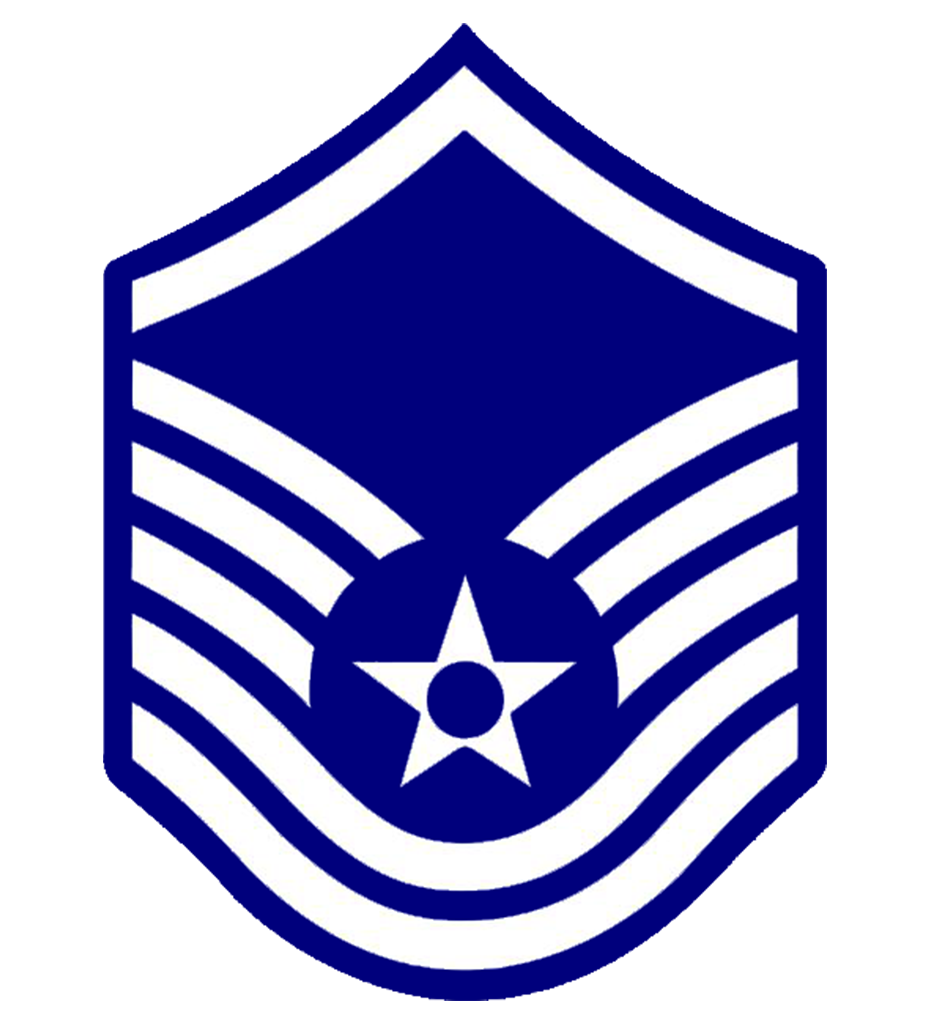
Description
- The rank of Air Force Master Sergeant is the platoon level Non-Commissioned Officer. They have proven themselves not only as an excellent leader in the past, but also as an effective guide for the unit as a whole. They have become a force to be reckoned with inside the company of their assignment and a trusted advisor to higher leadership. A Sergeant First Class is the counselor to all assigned NCOs below and helps direct them to success. The Air Force Master Sergeant is the very definition of an "Senior NCO".
- In the Air Force, the Master Sergeant is the most senior TACP in a Company sized element. They have the knowledge and ability to effectively help their commanding TACP Officer on all decisions, and the Commanding Officer to which they advise would do well to hold their knowledge to a high standard.
Role
- The primary role of an Air Force Master Sergeant is to follow the orders of an assigned Officer In Charge or supervisory NCO.
- The secondary role of an Air Force Master Sergeant is to delegate tasks by the OIC or supervisory NCO in charge to lesser NCOs.
- The tertiary role of an Air Force Master Sergeant is to help step up in leadership when the assigned supervisory leader is away and guide the assigned command.
- The quaternary role of a Air Force Master Sergeant is to attend courses hosted by TRADOC to expand their knowledge.
- The quinary role of a Air Force Master Sergeant is to create trainings and increase the overall proficiency of their assigned element.
Requirements
- In order to obtain the rank of Air Force Master Sergeant you must have the following:
- 285 calendar days honorable Time In Service (TIS) in the unit.
- Must have completed Senior Leaders Course (SLC)
- Must of displayed the characteristics and factors needed to become an NCO.
- Must be in a Platoon Level Billet
- Does not currently have a punitive flag against themselves.
*Course titles may vary. Ask Unit Leadership for more information.
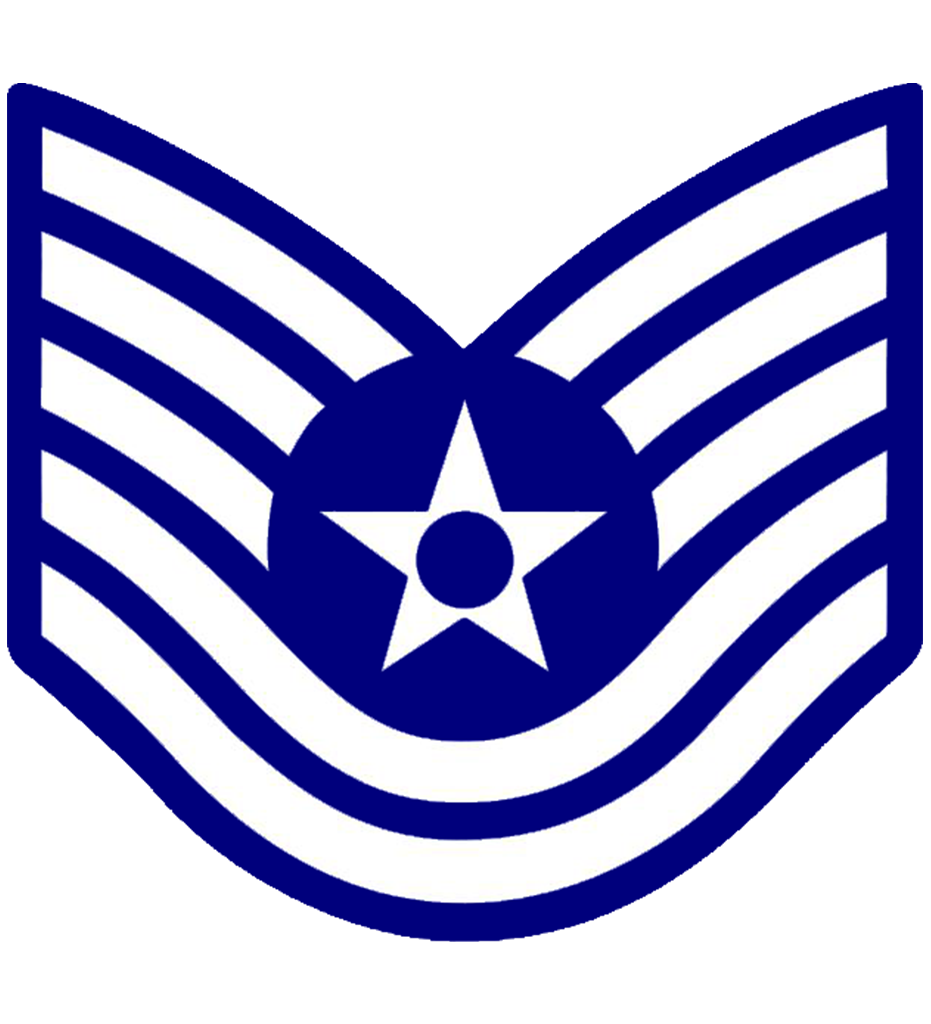
Description
- The rank of Technical Sergeant is a proficient and reliable leader within the unit. Their leadership has now evolved to a crucial part of the overall health of the unit, and not only does the Technical Sergeant excel in leadership, they also show the ability to assist higher leaders when called upon. A Technical Sergeant is the first step in intermediate leadership within the unit an thus comes with its own set of responsibilities, obligations, and requirements.
- In the Air Force, a Technical Sergeant is in command of a Tactical Air Control Party, or the 2IC to a Tactical Air Control Party Officer.
Role
- The primary role of an Technical Sergeant is to follow the orders of an supervisory NCO or leader.
- The secondary role of an Technical Sergeant is to delegate tasks by the supervisory NCO or leader to a lesser NCO.
- The tertiary role of an Technical Sergeant is to help step up in leadership when the assigned supervisory NCO or leader is away.
- The quaternary role of a Technical Sergeant is to attend courses hosted by TRADOC to expand their knowledge.
- The quinary role of a Technical Sergeant is to create trainings and increase the overall proficiency of their assigned element.
Requirements
- In order to obtain the rank of Technical Sergeant you must have the following:
- 210 calendar days honorable Time In Service (TIS) in the unit.
- Must have successfully completed at least 4 title course through TRADOC.
- Must have completed Advanced Leaders Course (ALC)
- Must of displayed the characteristics and factors needed to become an NCO.
- Must be in a billet for E-6+.
- Does not currently have a punitive flag against themselves.
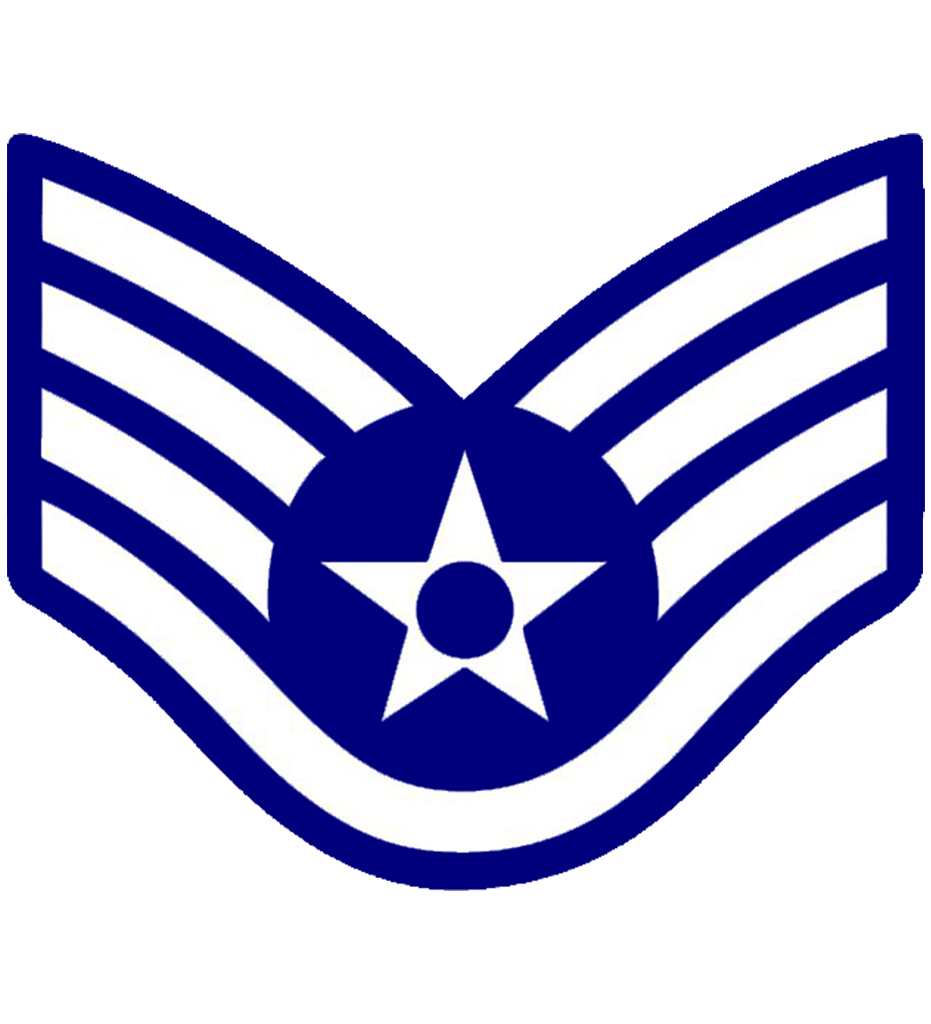
Description
- The rank of Air Force Staff Sergeant is the entrée to a hallowed fraternity to which they are now apart of. Air Force Staff Sergeants are the backbone and run the unit, of that there can be no doubt. A Staff Sergeant has proven to be a leader that can effectively control a Tactical Air Control Party if necessary. The rank of Staff Sergeant is where the axe meets the wood and all responsibilities are on the line.
Role
- The primary role of a Staff Sergeant is to follow the orders of an supervisory NCO or leader.
- The secondary role of a Staff Sergeant is to delegate tasks by the supervisory NCO or leader to a lesser NCO assigned.
- The tertiary role of a Staff Sergeant is to help step up in leadership when the assigned supervisory NCO or leader is away.
- The quaternary role of a Staff Sergeant is to attend courses hosted by TRADOC to expand their knowledge.
Requirements
- In order to obtain the rank of Staff Sergeant you must have the following:
- 150 calendar days honorable Time In Service (TIS) in the unit and 45 days honorable Time In Grade (TIG).
- Must have successfully completed at least 4 title course through TRADOC.
- Must have competed Advanced Leaders Course (ALC)
- Must of displayed the characteristics and factors needed to become an NCO.
- Does not currently have a punitive flag against themselves.
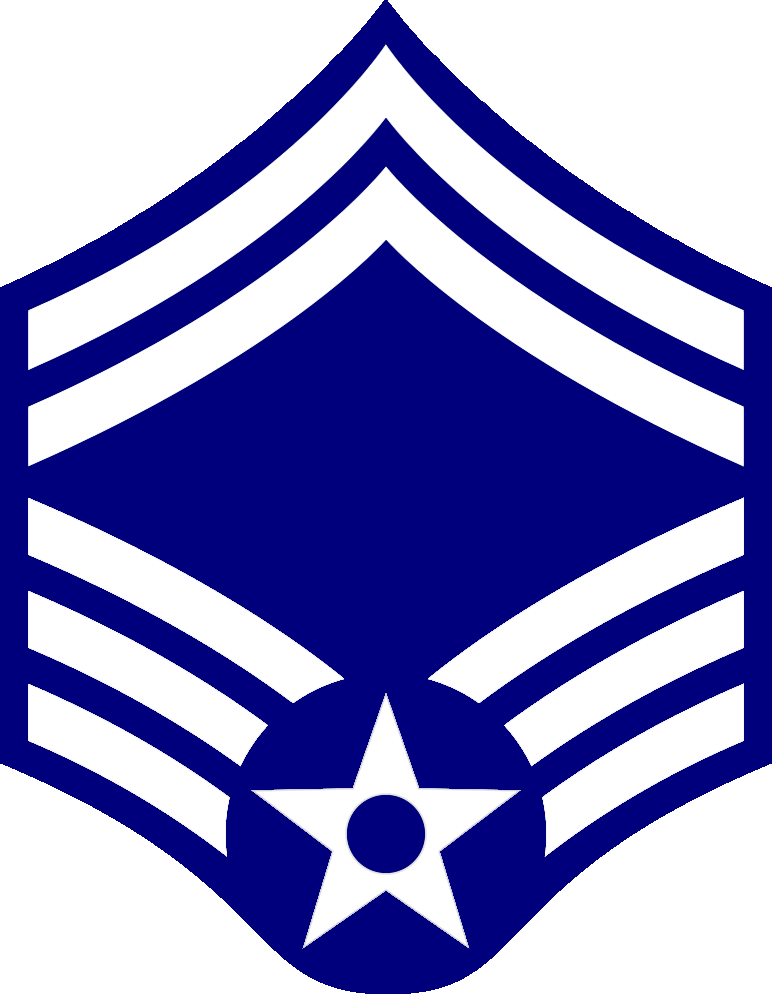
Description
- The Senior Airman Grade III is the lateral step into progression of the unit. Those who have been promoted to Senior Airman Grade III have either selected to remain in a non-leadership billeted position or are waiting for a leadership position to open for selection. Senior Airman Grade III much like Senior Airman is the most senior lower enlisted and contains vast knowledge within the unit and community. A Senior Airman Grade III is signified by the two chevrons on top of the original Senior Airman Insignia.
Requirements
- In order to obtain the rank of Senior Airman Grade III you must have the following:
- 190 calendar days honorable Time in Service (TIS) in the unit and 45 days Time in Grade (TIG).
- Must have successfully completed at least 3 non-Fox Company title courses through TRADOC.
- Does not currently have a punitive flag against themselves.
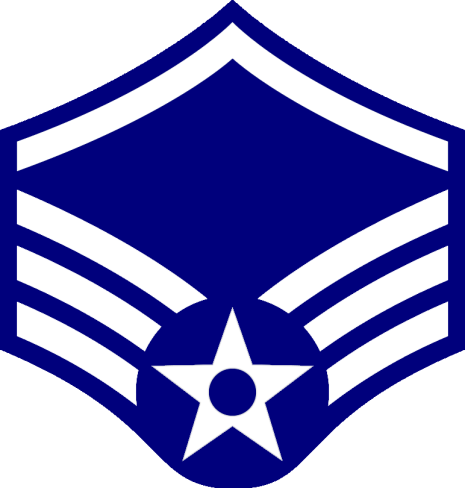
Description
- The Senior Airman Grade II is the lateral step into progression of the unit. Those who have been promoted to Senior Airman Grade II have either selected to remain in a non-leadership billeted position or are waiting for a leadership billet to open for selection. Senior Airman Grade II, much like Senior Airman is the most senior lower enlisted and contains vast knowledge within the unit and community. A Senior Airman Grade II is signified by the original Senior Airman Insignia with the addition of one chevron added to the top.
Requirements
- In order to obtain the rank of Senior Airman Grade II you must have the following:
- 150 calendar days honorable Time in Service (TIS) in the unit and 45 days Time in Grade (TIG).
- Must have successfully completed at least 2 non-Fox Company title courses through TRADOC.
- Does not currently have a punitive flag against themselves.
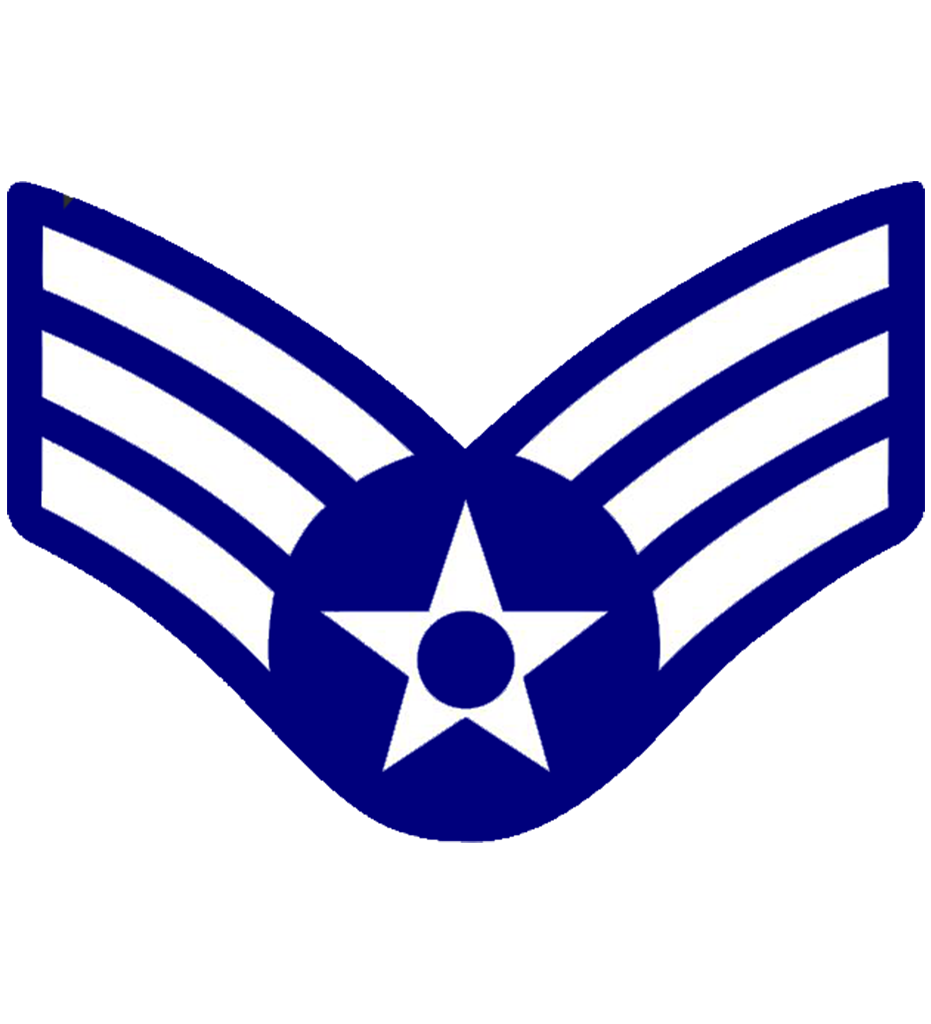
Description
- The Senior Airman is the top of the line of the junior enlisted ranks. A Senior Airman is not new but experienced in the unit and how it operates. As a Senior Airman you are trusted by your supervisory NCO or Leader to help delegate and task lower enlisted personnel and be the mentor for them when the supervisory NCO or Leader isn't there. This is the first step towards leadership within the unit and community.
Role
- The primary role of a Senior Airman is to follow the orders of the supervisory NCO or Leader.
- The secondary role of a Senior Airman is to help delegate tasks by the supervisory NCO or Leader.
- The tertiary role of a Senior Airman is to help step up in leadership when the assigned supervisory NCO or Leader is away.
- The quaternary role of a Senior Airman is to attend courses hosted by TRADOC to expand their knowledge.
Requirements
- In order to obtain the rank of Senior Airman you must have the following:
- 90 calendar days honorable Time in Service (TIS) in the unit and 45 days Time in Grade (TIG).
- Must have successfully completed at least 1 title course through TRADOC.
- Does not currently have a punitive flag against themselves.
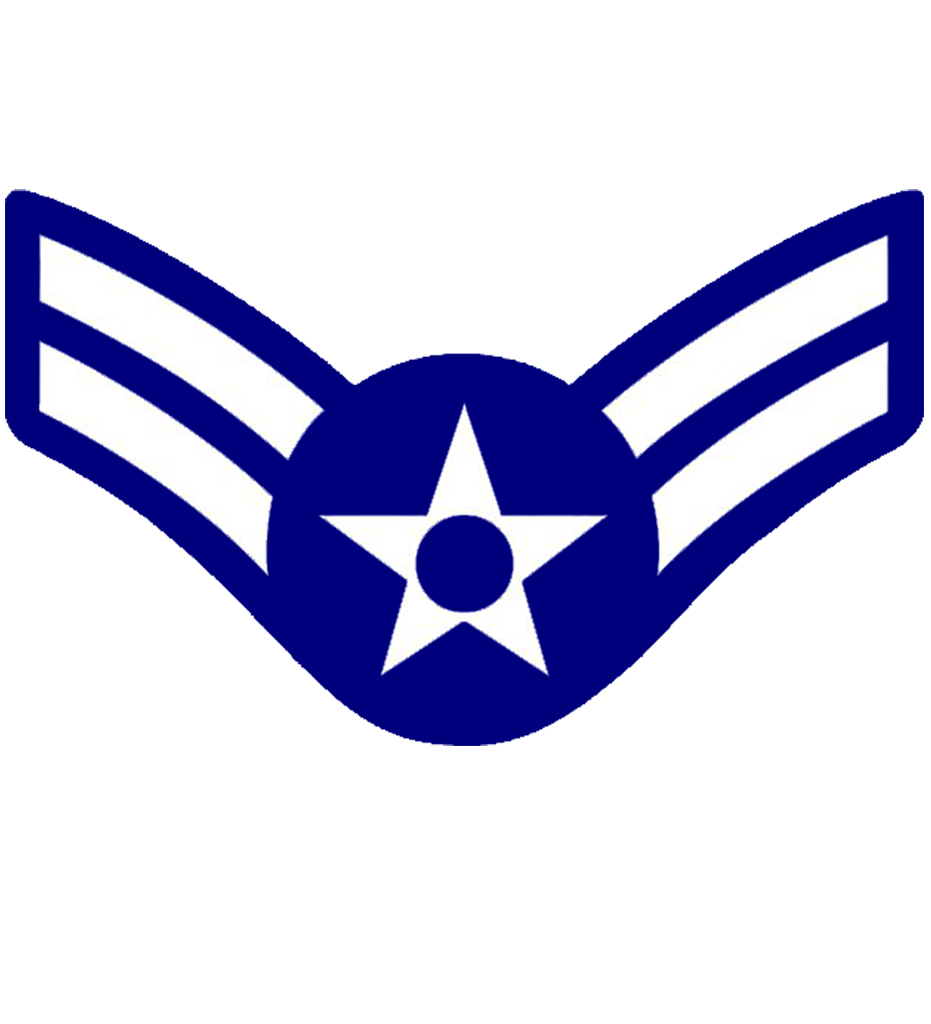
Description
- The Airman First Class rank is the first real step towards progression in the unit and community. Those who hold this rank have passed the milestone of induction, training, and the probationary period. The Airman First Class can be trusted upon for persistence, dedication, and activity for any role. A Airman First Class is the third enlisted rank of the junior enlisted line in the Air Force and follows the orders of their supervisory Non-Commissioned Officer (NCO).
Role
- The primary role of an Airman First Class is to follow the orders assigned by the supervisory NCO or Leader.
- The secondary role of an Airman First Class is to bet a Joint Terminal Air Controller in Fox Company.
- The tertiary role of an Airman First Class is to complete assigned courses hosted through TRADOC.
Requirements
- 6 Operations Attended,
- 30 Days TIS & 15 Days TIG.
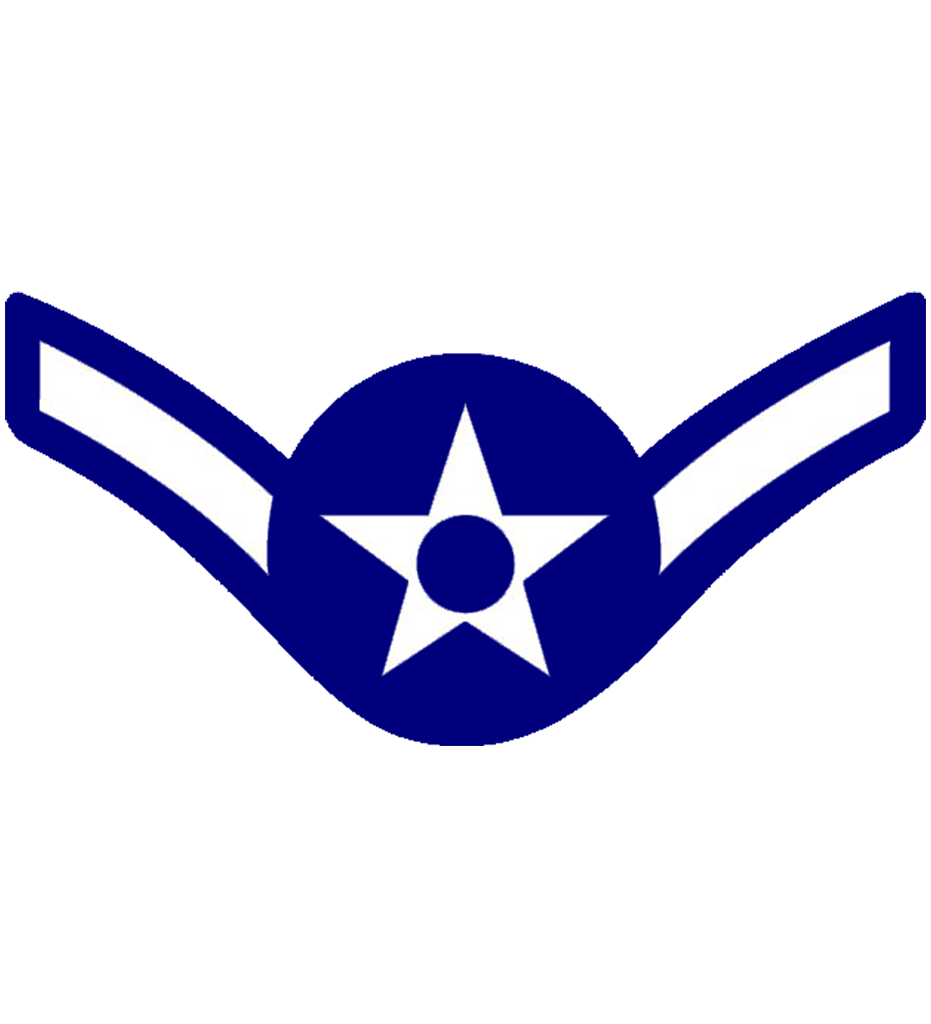
Description
- An Airman is the second step in the progression of the unit. An Airman much like the private is used as a marker for the unit to distinguish who has passed BCT, MOSQ and the first stage of the ROMAD Program as a Transport Pilot, and has now begun their probationary period. An Amn is eligible to still serve as a member and fill a dedicated role during operations such as a ROMAD Transport Pilot gaining their experience, or as a Joint Terminal Attack Controller once they have completed their Transport Pilot portion of the ROMAD Program.
Role
- The primary role of an Airman is to be as active as a member as possible given their real life situation and complete the ROMAD training program. Then act in the role of a Joint Terminal Attack Controller within Fox Company.
Requirements
- Completion of the ROMAD Program,
- 15 Days TIS/TIG,
- 4 Operations Attended,
- Qualifications: JTAC Transport Module, JTAC Attack Module, Call For Fire.
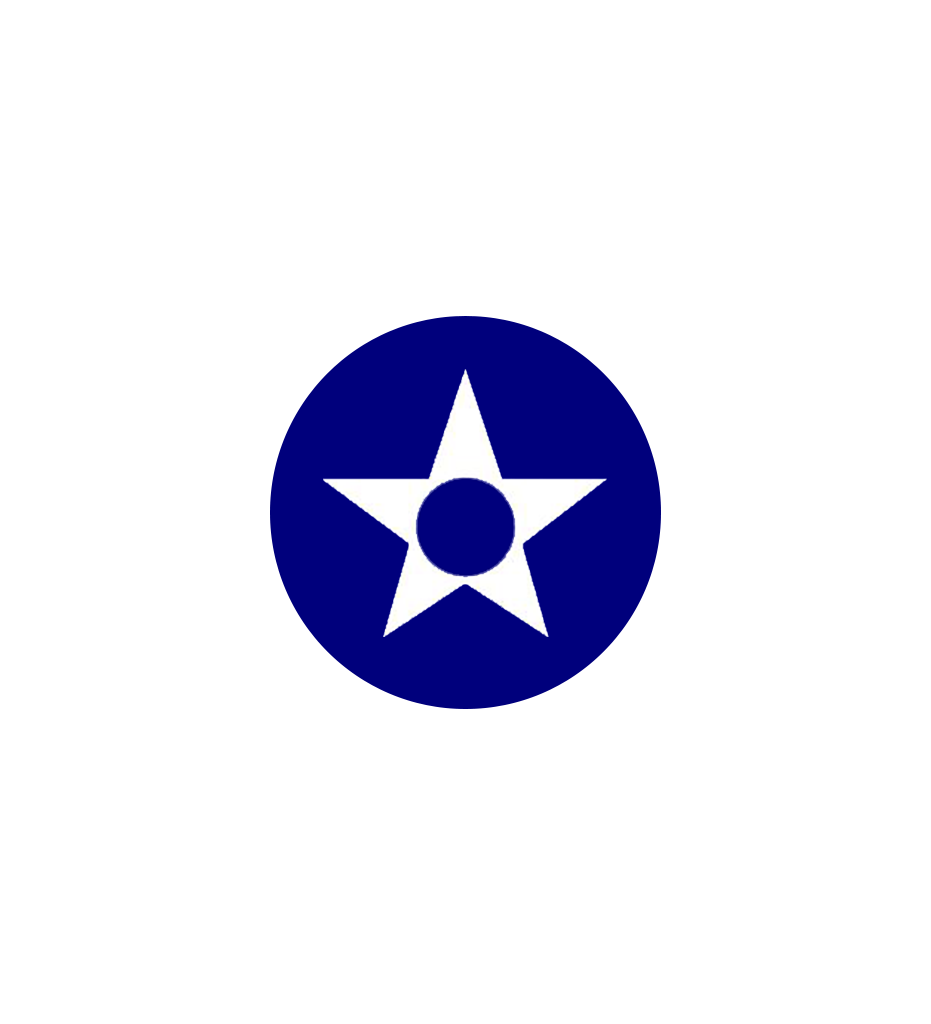
Description
- The rank of Airman Basic is given to those who have successfully completed their induction process through the Department of Unit Recruiting (DUREC). Airman Basic is purely used as a placeholder and a marker to the unit to signify that you have become a fully registered member of the unit, but yet to pass Basic Combat Training (BCT) and Military Occupational Speciality Qualification (MOSQ).
Role
- The primary role of an Airman Basic is to complete the Fox Co ROMAD Program, as well as further training to become an eventual Joint Terminal Attack Controller for Fox Company.
Requirements
- In order to obtain the rank of Airman Basic you must be inducted as a fully registered member in the 28th Combined Arms Division.
- Must have to applied and been accepted into Fox Company as a ROMAD, or future Joint Terminal Attack Controller prior to being promoted to Private Second Class.
- Qualifications: 1Z3X1, BCT, 11B.
